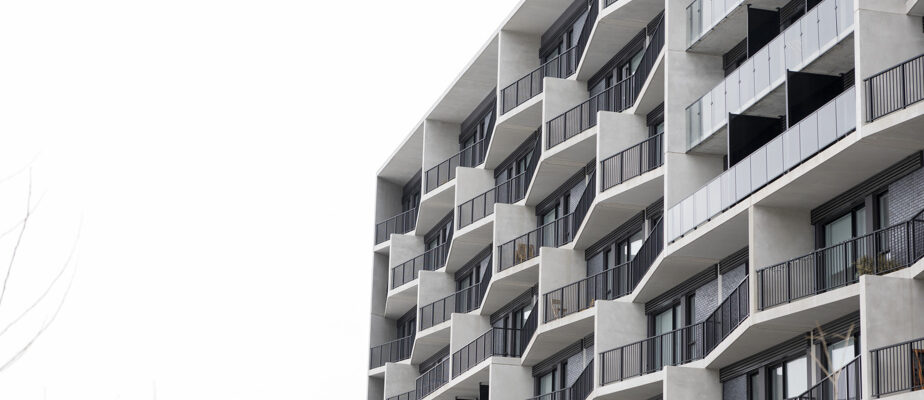Can simple balconies make a difference to a tall building’s carbon footprint? Absolutely, if we judge by the residential building Vivre1, designed by Montreal architect Maxime Frappier.
This 150-unit dwelling, built last year on the grounds of the former Outremont marshalling yard, stands out with its graceful asymmetrical balconies. Both sober and sophisticated, they play a major role in linking the old industrial buildings and the new campus of the Université de Montréal. The whole forms pretty cells with much more elegant lines than boring rectilinear balconies.

PHOTO PROVIDED BY ACDF ARCHITECTURE
The balconies designed for the Vivre1 project are insulated from the building structure to prevent them from transmitting summer heat and winter cold.
But these balconies are not just an aesthetic achievement. They also improve the energy balance of the building. How ? First of all, their manufacture in the factory generates little waste. They are also isolated from the structure of the building, so they do not transmit the heat of summer or the cold of winter to the dwellings.
“Just three easy-to-make molds with minimal waste. Simple, distinctive and durable”, summarizes Maxime Frappier, who foresees a flourishing future for prefabrication. “The benefits are many. Quality control, rapid closure of the building’s outer envelope, rapidly cleared streets, noise and dust reduced to a minimum… All this contributes to the acceptability of the project”, he underlines.
Pacific Coast Inspiration
The simplicity of this design is the result of a long process, begun more than five years ago, by the team of Maxime Frappier, president of ACDF Architecture. The trigger for this reflection? The mandate to design a luxurious 39-storey residential tower in downtown Vancouver.
However, it is not easy for a team of architects to reconcile design and the ambitious green requirements introduced by this municipality. Professionals are faced with ruthless regulations – “no derogation allowed”, specifies Maxime Frappier – on the protection of landscapes and areas of sunshine, as well as on energy efficiency.
“Western Canada is a step ahead of us in this regard,” says Maxime Frappier, who made his mark in 2014 by designing Vancouver’s new convention centre. “When we look at Quebec’s new energy code, it brings us back to what they asked of us there 10 years ago. »
“For example, one of the standards imposed there limits the number of windows in buildings to 40%, in order to optimize insulation. We, who were thinking of using curtain walls for our residential tower, had to throw everything in the trash, he recalls. This forced us to develop the project with a much more serious look at sustainable development. »
Aesthetics and energy
Back at the drawing board, the ACDF Architecture troops paid particular attention to the balconies. For what ? First of all, they are an essential element in the aesthetics of the building. Secondly, they greatly influence the carbon footprint of the construction.
Formwork scraps of various shapes often end up in the dump.
“If I conceive of a pattern that forces the builder to throw away a third of the materials, that’s unacceptable,” believes Maxime Frappier.
In addition, traditionally built balconies often transform a building into an energy abyss.

PHOTO MARCO CAMPANOZZI, THE PRESS
Montreal architect Maxime Frappier, president of ACDF architecture, pays particular attention to the balconies of high-rise buildings.
If the balcony is an extension of the interior concrete slab, it cools the apartment in winter and heats it in summer. We must then add an electric baseboard and an air conditioner. It’s wasted energy.
Maxime Frappier, president of ACDF Architecture
Receding balconies, that is to say, recessed in the facade and invisible from the street, can also seriously hamper the energy performance of a building, says Mr. Frappier. “If I have to add one or two 7-foot walls to set back part of the facade, that increases the length of the exterior envelope by one to two thirds. It is enormous ! »

PHOTO PROVIDED BY ACDF ARCHITECTURE
The luxurious residential tower The Pacific, designed by architect Maxime Frappier, is distinguished by its alternating full-length triangular balconies, with undersides tinted in various shades of gray.
The thinking paid off. Completed last year, the tower of Vancouver stands out in the landscape of the metropolis by the alternation of its large triangular balconies. This project has obtained LEED Gold certification awarded by the Canada Green Building Council.
Refinement
This technological success, in Vancouver as in Montreal, convinced the Montreal firm to pursue the refinement of its concept.

IMAGE PROVIDED BY ACDF ARCHITECTURE
The Barclay Tower, soon to be built in Vancouver, will benefit from the third generation of balconies created by Maxime Frappier’s team.
For a new high-rise residential project recently accepted in Vancouver, he created a repetition of graceful inverted teardrop balconies, in a very organic assemblage. Barely three forms will be needed to mold lightweight concrete one inch thick.
This new advance still leaves several questions unanswered, specifies Maxime Frappier. Is a balcony really necessary for a unit located at 30e stage ? Wouldn’t it be better to limit them to the first 10 floors and add large common terraces accessible to all?
“Balconies are a good example of the major changes we are going through. They offer plenty of opportunities to find the balance between efficiency and design,” he concludes.
